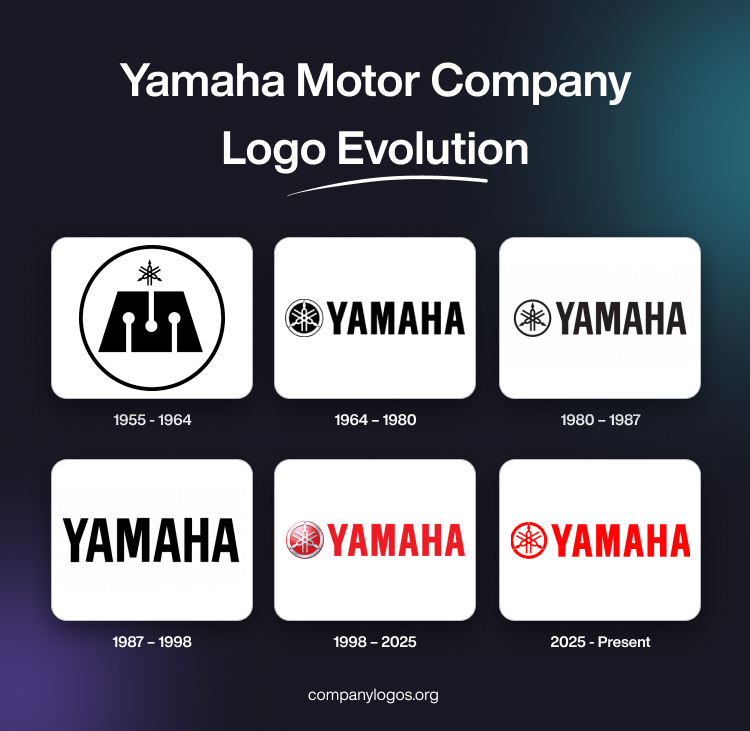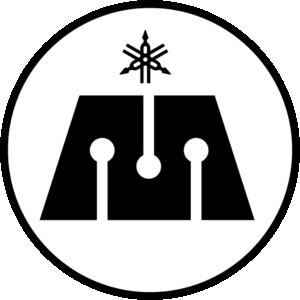
Yamaha Motor Company was established in 1955 as a spin-off from Yamaha Corporation to focus on motorcycles and motorised products. The logo of Yamaha Motor Company initially inherited the tuning fork symbol and later developed its own visual identity to distinguish itself from its parent company. The article delves into the logo evolution of Yamaha Motor Company, among other details.
The Genesis of the Yamaha Motor Company Logo (1955 – 1964)
The debut Yamaha Motor logo featured a large “M” in solid black and three tuning forks, also with black outlines. The stylised tuning forks were arranged in a pattern—one at the centre and two crisscrossing the one at the centre from the right and left. The tuning fork symbol was placed above the “M” symbol to thank the parent company that makes musical instruments. The elements, tuning forks, and the “M” symbol were placed within a hollow black outline. The design honoured the musical heritage of the company while establishing its new direction in motorised products.

(1964 – 1980)
The 1964 logo variant of the Yamaha Motor Company saw several changes. These include the removal of the large “M” and the reconfiguration of the tuning forks and enclosing them in a double ring. The tuning forks were depicted in white against a solid black circular background. The edge between the two concentric circles (solid black at the centre and one with a surrounding black outline) was shown in white. Besides, the brand name “YAMAHA” was added to the right of the tuning fork symbol. It was rendered in black in a clean, modern font to enhance readability and brand recognition.

(1980 – 1987)
In the 1980 logo iteration, the previous logo elements, such as the tuning forks symbol, were retained, but with changes to their colours. For instance, the emblem was made lighter by switching the colours of the tuning forks (white to black) and the background (black to white). Besides, the lines of the letters in the wordmark were refined to make them appear more elegant.

(1987 – 1998)
The logo iteration of 1987 saw the removal of the tuning fork emblem, while retaining the single wordmark “YAMAHA” in bold uppercase. The emblem was removed to achieve a minimalist and modern appearance.

(1998 – 2025)
The previous logo design was refined by changing the colour combination. The tuning fork emblem was changed into metallic grey and gradient red. The circle in the background and edge lines were coloured in gradient red, while the dividing stripe and forks were given a metallic hue. The wordmark, on the other hand, was rendered in bright red.

(2025 – Present)
For the first time in 27 years, Yamaha Motor Company updated its logo to coincide with its 70th anniversary. The new design features a flat tuning fork emblem in two dimensions set against a white background. It is optimised for digital platforms and modern branding needs. The wordmark in a traditional sans-serif typeface sits beside the emblem in red. The tagline “Revs Your Heart” is placed below in black with extended legs of “R” and “Y” underscoring the rest of the letters.

The Elements of the Yamaha Motor Company Logo
Symbol
The tuning forks symbolising the musical heritage of the company are arranged in a configuration to symbolise the wheel of a motorcycle. The tuning forks represent “The Customer,” “The Society,” and “The Individual.” These are the principles followed by the company to create value in order to surpass customer expectations. Also, these are aimed at fulfilling responsibilities as a corporation to the society.
Font
The wordmark used as a part of the logo of the Yamaha Motor Company is rendered in a traditional and bold sans-serif typeface. It is similar to the Helvetica Bold Condensed font.
Colour
The colour used in designing the tuning fork emblem as well as rendering the wordmark “Yamaha” is vibrant red. However, the colour of the tagline “Revs Your Heart” is shown in black.
The History of Yamaha Motor Company
Yamaha Motor Company has a rich and dynamic history that began in post-war Japan. It was officially established on July 1, 1955, as a spin-off from Nippon Gakki Co., Ltd. (now Yamaha Corporation) under the leadership of Genichi Kawakami. Kawakami wanted to repurpose the company’s wartime manufacturing facilities for peacetime production. He eventually decided to enter the motorcycle market after considering options like sewing machines and auto parts.
The very first product of the company was the YA-1, a 125cc, two-stroke, single-cylinder motorcycle inspired by the German DKW RT 125. Released in 1955, the YA-1 quickly made a name for itself by winning the 125cc class at the Mount Fuji Ascent Race. It also swept the podium at the All Japan Autobike Endurance Road Race.
In the late 1950s and 1960s, Yamaha rapidly expanded its product range and technological capabilities. In 1957, the company introduced the YA-2, which featured an improved frame and suspension, as well as the YD-1, a 250cc two-stroke twin-cylinder motorcycle. Yamaha made its international racing debut at the Catalina Grand Prix in the United States in 1958 and, that same year, established its first overseas subsidiary in Mexico.
In the following year, in 1959, Yamaha released the YDS1, the first full-fledged sports motorcycle by a Japanese manufacturer. It was known for its five-speed transmission, which was a first for Japanese motorcycles. During this time, Yamaha also ventured into the marine sector and launched its first outboard motor. It developed boats using innovative fibreglass-reinforced plastic (FRP) materials.
As Yamaha Motor Company moved into the 1970s and beyond, it continued to innovate and diversify. The company expanded its product offerings to include all-terrain vehicles, snowmobiles, and watercraft. It also entered into partnerships, such as collaborating with Toyota on the iconic Toyota 2000GT sports car. It also became a major force in international motorcycle racing by winning numerous championships with legendary riders.
Yamaha’s expertise in engine development led to collaborations with automotive partners. These included the creation of a high-performance engine for the Ford Taurus SHO in the 1990s. The company’s commitment to research and development resulted in industry breakthroughs like the Autolube system for two-stroke engines and the creation of the trail bike segment.
Yamaha Motor Company is based in Iwata, Shizuoka, Japan, and it operates globally to produce motorcycles, marine engines, boats, ATVs, and more. Its legacy is built on a foundation of innovation, performance, and a pioneering spirit that began with Genichi Kawakami’s vision in the 1950s.
Some of the key milestones in Yamaha’s history include its founding and the release of the YA-1 motorcycle in 1955 and the establishment of its first international subsidiary and racing debut in 1958. Also, the introduction of the YDS1 sports motorcycle with a five-speed transmission in 1959. Yamaha’s ongoing expansion into marine, automotive, and power products, along with its global motorsport success, underscores a story of adaptability, ambition, and relentless innovation in the world of mobility.
Interesting Facts About the Yamaha Motor Company
- Founded in 1955, Yamaha Motor Company was spun off from Yamaha Corporation, the musical instrument manufacturer.
- Its first product was the YA-1, a 125cc two-stroke motorcycle nicknamed “Akatombo” (Red Dragonfly). It won major races in Japan right after its release.
- Yamaha is one of the “Big Four” Japanese motorcycle manufacturers, alongside Honda, Suzuki, and Kawasaki.
- The company made its international racing debut in 1956 at the Catalina Grand Prix in the U.S.
- Legendary riders like Valentino Rossi, Jorge Lorenzo, and Wayne Rainey have raced for Yamaha in MotoGP.
- Yamaha won its 500th Grand Prix victory in 2022. It became one of the most successful manufacturers in motorcycle racing history.
- Yamaha is the world’s largest manufacturer of outboard motors.
- Yamaha is known for pioneering 4-stroke outboard engines, which are cleaner and more fuel-efficient than 2-stroke versions.
- Yamaha also makes personal watercraft (Jet Skis), inflatable boats, and high-performance marine engines.
- Besides motorcycles and marine products, Yamaha makes:
- All-terrain vehicles (ATVs)
- Snowmobiles
- Golf cars
- Robotics and drones
- Industrial-use unmanned helicopters for agricultural spraying.
- Yamaha has been investing in electric mobility, including electric scooters and bicycles (like the Yamaha E-Bike Systems).
- It introduced the EMF electric scooter and continues to explore hydrogen-powered engines.
- Yamaha operates in over 180 countries, with manufacturing facilities in Japan, India, Indonesia, Vietnam, and more.
- India is one of Yamaha’s biggest two-wheeler markets, with popular models like the FZ, R15, and MT series.
- Yamaha Motor retains the three-tuning-fork logo from its musical roots. It symbolises its connection to harmony in engineering, production, and marketing.
- Despite being separate companies since 1955, Yamaha Corporation still holds a significant stake in Yamaha Motor Company.
Finally
The Yamaha Motor Company logo is more than a corporate symbol. It is a visual narrative of the company’s journey from a musical instrument maker to a global leader in motorised products. Each evolution of the logo reflects Yamaha’s commitment to innovation, quality, and its harmonious blend of tradition and progress.